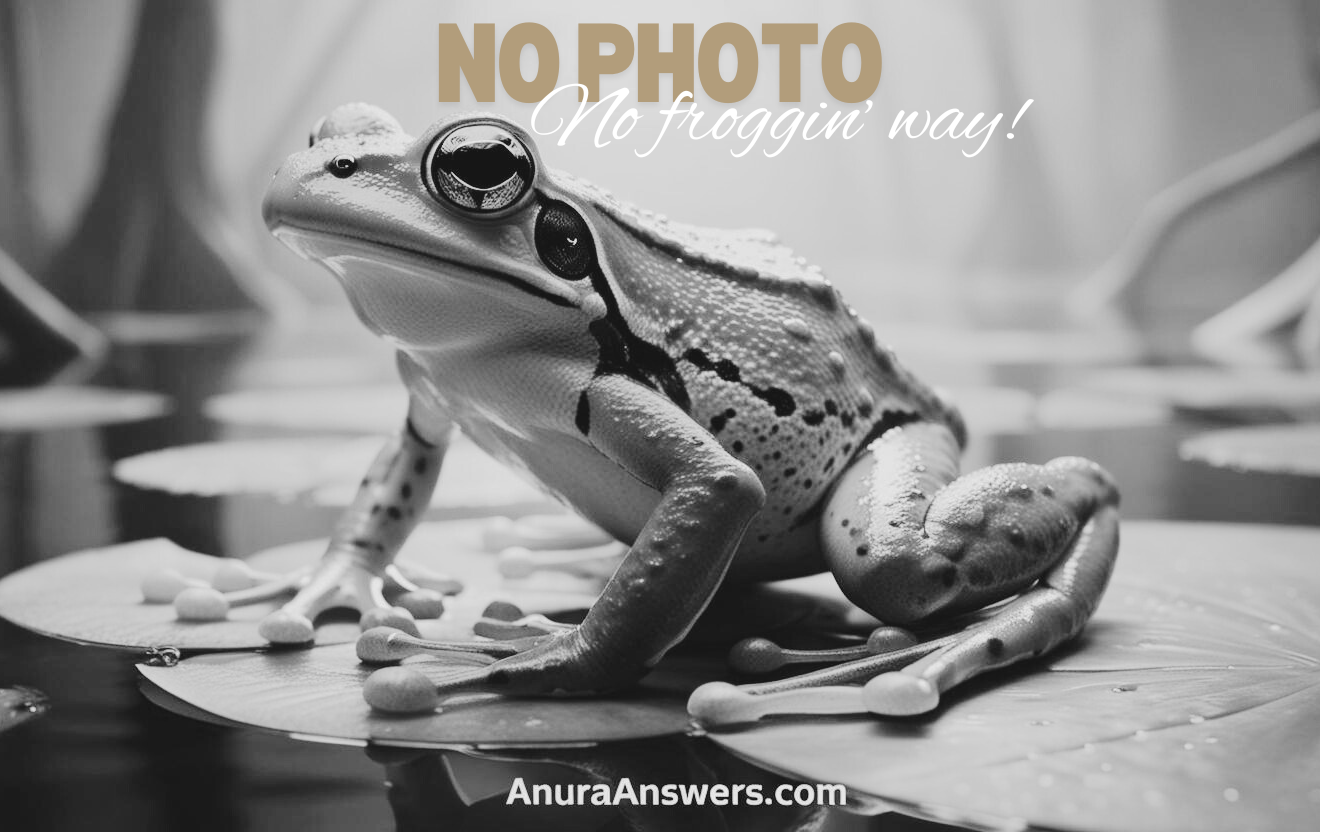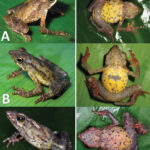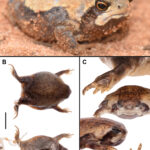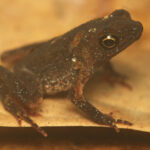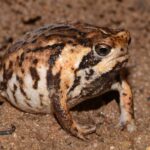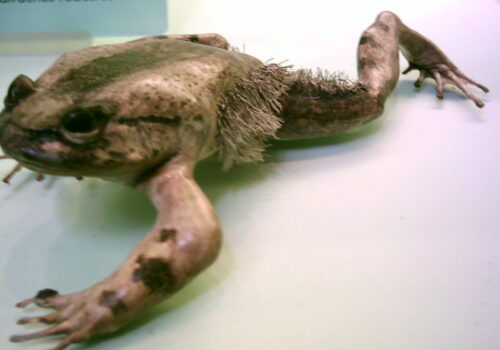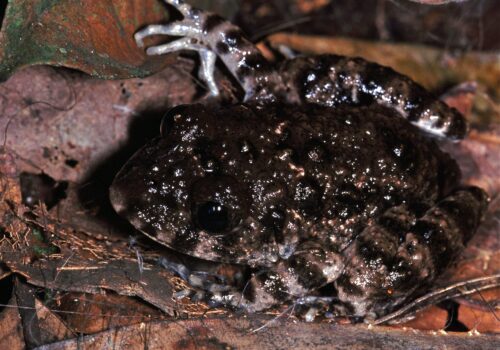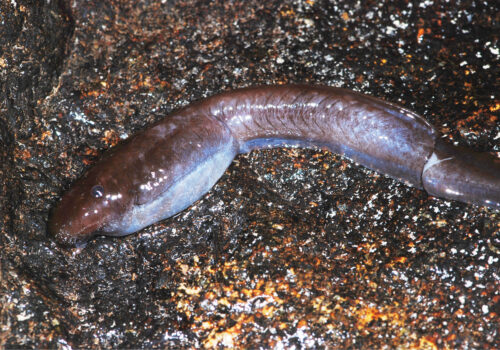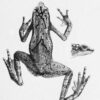Discovering the Beautiful Squeaker Frog: A Journey into the World of Arthroleptis formosus#
Hidden amidst the lush, moss-covered floor of West Africa’s rainforest lies an elusive creature whose enchanting calls are heard more often than its delicate body is seen. Known scientifically as Arthroleptis formosus, or commonly called the “Beautiful Squeaker Frog,” this diminutive amphibian is remarkable not just for its entrancing vocalization but for the vital ecological role it quietly inhabits.
Though small in stature, typically measuring only a few centimeters, this frog possesses qualities that captivate scientists and naturalists alike. Its peculiar method of reproduction, subtle yet distinct physical adaptations, and fragile existence intertwined vividly with its habitat, create a rich story of survival, intrigue, and vulnerability.
In this narrative journey through tropical forests and undergrowth, we delve deeply into the fascinating world of Arthroleptis formosus, exploring its taxonomy, habitat preferences, unique lifestyle, ecological contributions, conservation challenges, and mysterious charm—only to emerge with greater appreciation and determination to protect such often-overlooked wonders.
Taxonomy and Classification#
Belonging to the diverse family Arthroleptidae, Arthroleptis formosus is part of a genus commonly referred to as “squeakers” due to their distinctively high-pitched vocalizations. The genus Arthroleptis comprises numerous species spread throughout Sub-Saharan Africa, each possessing its unique blend of coloration, anatomy, and habits.
Formally described in 1909 by scientists in the field, A. formosus, whose species epithet aptly means “the beautiful one,” has since fascinated researchers and conservationists because of its attractive markings and cryptic lifestyle. This frog’s taxonomy has remained relatively stable over the years; however, genetic and molecular studies occasionally reveal exciting insights into the evolutionary relationships among Arthroleptis species, reinforcing the fascinating diversity in this extraordinary amphibian family.
Natural Habitat#
Deep in the humid lowland and montane forests of West Africa—primarily found within forested regions of Cameroon and Nigeria—Arthroleptis formosus thrives in a delicately fine-tuned habitat. This species prefers undisturbed natural habitats, favoring the damp, sheltered microclimates beneath fallen trees, forest litter, thick foliage, and moss-covered rocks.
Throughout these lush habitats, temperatures remain stable, and moisture prevails, critical conditions for the thin-skinned amphibian. Gentle streams, puddles, and pools of rainwater collect in quiet depressions, thus providing an ideal setting for their unique reproductive cycle. Unlike many amphibians, this frog remarkably bypasses a typical aquatic larval stage—eggs deposited thoughtfully in moist soil hatch directly into miniature versions of adults, fully terrestrial from the outset.
The forests inhabited by A. formosus are resilient ecosystems bustling with biodiversity—from towering trees and bromeliads to orchids and fungi, enlivened by abundant insect, reptile, and bird life. Such diversity supports the delicate balance necessary for the frog’s survival, and conversely, the frog itself contributes significantly to the delicate web of life through its predatory behavior.
Physical Characteristics#
The aptly named “Beautiful Squeaker Frog” exhibits distinct and notable visual traits. Measuring roughly two centimeters in length, this petite amphibian showcases coloration ranging from earthy browns tinged with rich rusty hues to soft greys and yellows. Intricate markings—dark patches or blotches across their dorsal surface—function as exquisite camouflage amid leaf litter, shadows, and decaying vegetation, allowing them to evade hungry predators.
Their slender limbs are delicately muscled yet surprisingly sturdy, perfectly adapted for swift, calculated leaps through dense underbrush. Additionally, their slightly pointed snouts and pronounced eyes grant exceptional vision and perception capabilities. Exceptional vision paired with acute hearing makes them adept predators, relying heavily on these refined senses rather than size or brute strength.
This cocktail of physical adaptations enables them to withstand the demands of life on the forest floor, profoundly enhancing survival capacity in their chosen habitat.
Behavior and Life Cycle#
Perhaps the most enchanting aspect of the Beautiful Squeaker Frog lies within its behavior and intricate life cycle. Much of their existence is nocturnal, active under the cloak of darkness, when the cool breeze and silhouetted foliage offer protection from diurnal predators. During these nightly exploits, they exhibit efficient and meticulous hunting behaviors, preying primarily on ants, termites, beetles, and other small forest invertebrates.
Their modus operandi is simple yet efficient—patiently lying in wait, blending seamlessly with the surrounding litter. When prey ventures near, these small but swift predators snap into action with skillful leaps and precise strikes utilizing sticky tongues adapted for efficiently securing insects mid-flight.
A Unique Reproductive Approach#
A striking adaptation that distinguishes A. formosus from many amphibians lies in its uncommon approach to breeding. While most frogs rely heavily on aquatic environments for reproduction, laying eggs in ponds or flowing streams, A. formosus sidesteps any requirement for permanent water bodies altogether.
In moist, shaded forest floors, female frogs carefully deposit eggs within damp soil nests—a deliberate, hidden nursery void of standing water. After a remarkably short incubation period, these eggs hatch directly into tiny froglets, miniature replicas of their parents. This unusual process—known scientifically as direct development—is efficient, as it frees this amphibian population from dependence on potentially unpredictable aquatic ecosystems. However, the consequence of this independence is complete reliance on intact, consistently moist forest habitats, making them exceptionally vulnerable to environmental changes.
Ecological Role#
Small yet indispensable, Arthroleptis formosus fills multiple essential ecological niches within its rainforest home. Primarily insectivorous, the Beautiful Squeaker significantly regulates insect populations, contributing profoundly toward controlling pest levels and assisting in forest ecosystem balance.
Being relatively small amphibians, they also serve an integral role as prey species. Snakes, birds, larger amphibians, and invertebrate predators feed upon them, placing the frog firmly within an interconnected food web. Furthermore, frogs like A. formosus are considered indicator species: sensitive animals whose reproductive success and population health illustrate vividly the state and “integrity” of forest habitats. Declining populations frequently signal subtle or overt changes within environmental conditions, alerting conservationists to act swiftly and decisively to protect entire ecosystems in peril.
Threats and Conservation Status#
The International Union for Conservation of Nature (IUCN) currently classifies Arthroleptis formosus as Least Concern, as populations seem stable within their restricted range. Nevertheless, the fragility of the species’ unique reproductive methods, dependence upon pristine forest conditions, and susceptibility to habitat destruction pose ongoing concerns that must not be overlooked.
Primary threats to its survival include rapid deforestation across West Africa due to logging, intensive agriculture, mining activities, and expanding human settlements leading to significant habitat fragmentation. Climate change further poses considerable threats, with seasonal rains becoming more unpredictable—a devastating reality for a species intimately tied to consistent moisture conditions.
Focused conservation actions informed by ongoing research—such as habitat monitoring, establishment of protected areas, and community outreach emphasizing sustainable resource use—are essential for ensuring this miniature marvel continues enchanting future generations.
Cultural and Scientific Significance#
While often overshadowed by more emblematic African species such as elephants or gorillas, frogs such as A. formosus quietly underscore deep-rooted cultural ties, scientific breakthroughs, and ecological importance. Amphibians frequently feature in local folklore and traditional beliefs, often symbolizing fertility, rain-making ceremonies, or magical powers.
Scientifically, each amphibian contributes potential biological secrets, from undiscovered substances or toxins beneficial in medicine to precise ecological indicators pivotal for climate and environmental management.
Conclusion#
The Beautiful Squeaker Frog, Arthroleptis formosus, beautifully illustrates how even the smallest, subtlest creatures possess intrinsic ecological and cultural value. Yet, it is simultaneously emblematic of larger conservation challenges facing the world’s biodiversity today. Let their gentle voices inspire action, vigilance, and commitment to safeguarding our frail but irreplaceable natural heritage.
With conscientious stewardship, future generations will continue unraveling the mysteries of these delicate amphibians’ lives, reinforcing humanity’s place in protecting nature in all its forms.
